
V Corps, formerly known as the Fifth Corps, is a regular corps of the United States Army at Fort Knox. It was previously active during World War I, World War II, the Cold War, the Kosovo War, and the War on Terrorism.
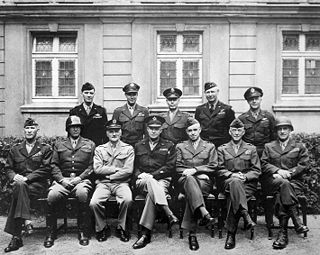
The European Theater of Operations, United States Army (ETOUSA) was a Theater of Operations responsible for directing United States Army operations throughout the European theatre of World War II, from 1942 to 1945. It commanded Army Ground Forces (AGF), United States Army Air Forces (USAAF), and Army Service Forces (ASF) operations north of Italy and the Mediterranean coast. It was bordered to the south by the North African Theater of Operations, United States Army (NATOUSA), which later became the Mediterranean Theater of Operations, United States Army (MTOUSA).
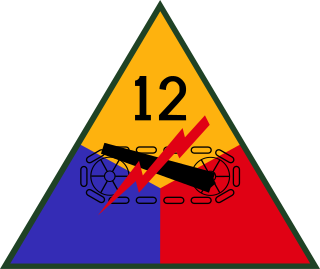
The 12th Armored Division was an armored division of the United States Army in World War II. It fought in the European Theater of Operations in France, Germany and Austria, between November 1944 and May 1945.

The 14th Armored Division was an armored division of the United States Army assigned to the Seventh Army of the Sixth Army Group during World War II. It remains on the permanent roll of the Regular Army as an inactive division, and is eligible for reactivation. The division is officially nicknamed the "Liberators".

The Twelfth United States Army Group was the largest and most powerful United States Army formation ever to take to the field, commanding four field armies at its peak in 1945: First United States Army, Third United States Army, Ninth United States Army and Fifteenth United States Army. Formed eight days after the Normandy landings, it initially controlled the First and the Third US Armies. Through various configurations in 1944 and 1945, the Twelfth US Army Group controlled the majority of American forces on the Western Front. It was commanded by General Omar Bradley with its headquarters established in London on 14 July 1944.

The VI Corps was activated as VI Army Corps in August 1918 at Neufchâteau, France, serving in the Lorraine Campaign. Constituted in the Organized Reserves in 1921, it was allotted to the Regular Army in 1933 and activated on 1 August 1940 at Fort Sheridan, Illinois. VI Corps took part in some of the most high-profile operations in World War II.
The Mediterranean Theater of Operations, United States Army (MTOUSA), originally called the North African Theater of Operations, United States Army (NATOUSA), was a military formation of the United States Army that supervised all U.S. Army forces which fought in North Africa and Italy during World War II.
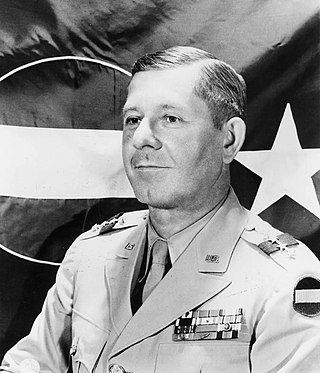
Jacob Loucks Devers was a general in the United States Army who commanded the 6th Army Group in the European Theater of World War II. He was involved in the development and adoption of numerous weapons, including the M4 Sherman and M26 Pershing tanks, the DUKW amphibious truck, the Bell H-13 Sioux helicopter, and the M16 rifle.

General Alexander McCarrell Patch was a senior United States Army officer who fought in both world wars, rising to rank of general. During World War II, he commanded U.S. Army and Marine Corps forces during the Guadalcanal Campaign in the Pacific, and the Seventh Army on the Western Front in Europe.

The Colmar Pocket was the area held in central Alsace, France, by the German Nineteenth Army from November 1944 to February 1945, against the U.S. 6th Army Group during World War II. It was formed when 6th AG liberated southern and northern Alsace and adjacent eastern Lorraine, but could not clear central Alsace. During Operation Nordwind in December 1944, the 19th Army attacked north out of the Pocket in support of other German forces attacking south from the Saar into northern Alsace. In late January and early February 1945, the French First Army cleared the Pocket of German forces.
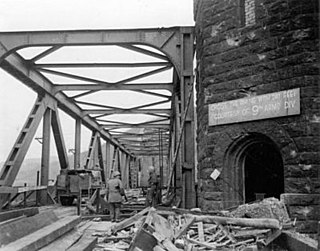
Operation Lumberjack was a military operation with the goal of capturing the west bank of the Rhine River and seizing key German cities, near the end of World War II. The First United States Army launched the operation in March 1945 to capture strategic cities in Nazi Germany and to give the Allies a foothold along the Rhine.
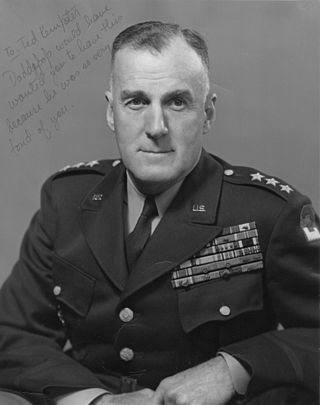
Lieutenant General Edward Hale Brooks was a senior officer of the United States Army, a veteran of both World War I and World War II, who commanded the U.S. Second Army during the Korean War. He received the Distinguished Service Cross (DSC) for heroism as a young officer in World War I and commanded the 2nd Armored Division during the Battle of Normandy as well as VI Corps during the subsequent defeat of German forces in World War II.

The Western Allied invasion of Germany was coordinated by the Western Allies during the final months of hostilities in the European theatre of World War II. In preparation for the Allied invasion of Germany east of the Rhine, a series of offensive operations were designed to seize and capture its east and west banks: Operation Veritable and Operation Grenade in February 1945, and Operation Lumberjack and Operation Undertone in March 1945; these are considered separate from the main invasion operation. The Allied invasion of Germany east of the Rhine started with the Western Allies crossing the river on 22 March 1945 before fanning out and overrunning all of western Germany from the Baltic in the north to the Alpine passes in the south, where they linked up with troops of the U.S. Fifth Army in Italy. Combined with the capture of Berchtesgaden, any hope of Nazi leadership continuing to wage war from a so-called "national redoubt" or escape through the Alps was crushed, shortly followed by unconditional German surrender on 8 May 1945. This is known as the Central Europe Campaign in United States military histories.
The firstArmy Corps was first formed before World War I. During World War II it fought in the Campaign for France in 1940, on the Mediterranean islands of Corsica and Elba in 1943 - 1944 and in the campaigns to liberate France in 1944 and invade Germany in 1945.

The Northern Army Group (NORTHAG) was a NATO military formation comprising four Western European Army Corps, during the Cold War as part of NATO's forward defence in the Federal Republic of Germany.
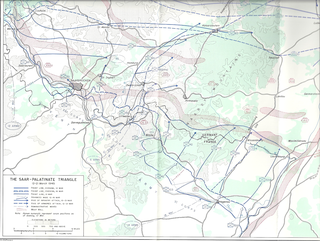
Operation Undertone, also known as the Saar-Palatinate Offensive, was a large assault by the U.S. Seventh, Third, and French First Armies of the Sixth and Twelfth Army Groups as part of the Allied invasion of Germany in March 1945 during World War II.

Major General Roderick Random Allen was a senior United States Army officer, who commanded the 20th and 12th Armored Divisions during World War II. Under his command of the 12th AD, the division defended Strasbourg from recapture; it provided the armored contingent in the closure of the Colmar Pocket and the liberation of Colmar; it spearheaded General George Patton's drive to the Rhine; captured intact the remaining bridge over the Danube River and broke the German defense line; and played a major part in blocking the Brenner Pass, thereby trapping over a million German soldiers in Italy as the war ended. En route to the Brenner Pass it overran eleven concentration camps at Landsberg, Germany.

The Seventh Army was a United States army created during World War II that evolved into the United States Army Europe (USAREUR) during the 1950s and 1960s. It served in North Africa and Italy in the Mediterranean Theater of Operations and France and Germany in the European Theater between 1942 and 1945.
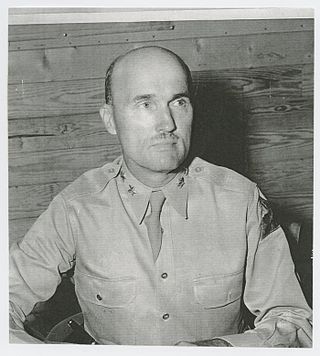
Major General Carlos Brewer was a United States Army officer who commanded the 12th Armored Division during World War II. After training the 12th Armored Division, he was not permitted to command the division in combat due to his age, so he requested his rank be reverted from major general to Colonel so that he could become an artillery officer in the European Theater of Operations (ETO). He innovated the method of field artillery targeting used in World War II, and implemented triangular organization of divisions.
The battle of the Mons pocket was an engagement fought between Allied and German forces during late August and early September 1944. It formed part of the final stages of the rapid Allied advance across France and Belgium. During the battle United States Army forces, assisted by the Belgian Resistance, encircled a large number of retreating German Army and Waffen-SS troops near the town of Mons in Belgium. The German forces were disorganised and unable to counter the Allied forces. Around 3,500 Germans were killed and 25,000 made prisoners of war. Allied casualties were light.


















